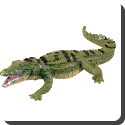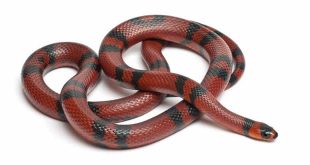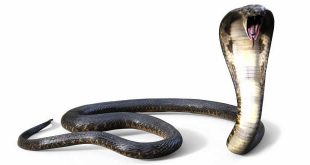 Crocodile — A crocodile is any species belonging to the family Crocodylidae (sometimes classified instead as the subfamily Crocodylinae). The term can also be used more loosely to include all members of the order Crocodilia: i.e. the true crocodiles, the alligators and caimans (family Alligatoridae) and the gharials (family Gavialidae), or even the Crocodylomorpha which includes prehistoric crocodile relatives and ancestors. Crocodiles are large aquatic reptiles that live throughout the Tropics in Africa, Asia, the Americas and Australia. Crocodiles tend to congregate in freshwater habitats like rivers, lakes, wetlands and sometimes in brackish water. Some species, notably the Saltwater Crocodile of Australia, Southeast Asia and the Pacific islands often live along the coastal areas. They are also known to venture far out to sea. They mostly feed on vertebrates like fish, reptiles, and mammals, sometimes with invertebrates like mollusks and crustaceans, depending on species. They are an ancient lineage, and are believed to have changed little since the time of the dinosaurs.
Crocodile — A crocodile is any species belonging to the family Crocodylidae (sometimes classified instead as the subfamily Crocodylinae). The term can also be used more loosely to include all members of the order Crocodilia: i.e. the true crocodiles, the alligators and caimans (family Alligatoridae) and the gharials (family Gavialidae), or even the Crocodylomorpha which includes prehistoric crocodile relatives and ancestors. Crocodiles are large aquatic reptiles that live throughout the Tropics in Africa, Asia, the Americas and Australia. Crocodiles tend to congregate in freshwater habitats like rivers, lakes, wetlands and sometimes in brackish water. Some species, notably the Saltwater Crocodile of Australia, Southeast Asia and the Pacific islands often live along the coastal areas. They are also known to venture far out to sea. They mostly feed on vertebrates like fish, reptiles, and mammals, sometimes with invertebrates like mollusks and crustaceans, depending on species. They are an ancient lineage, and are believed to have changed little since the time of the dinosaurs.
Crocodiles are among the more biologically complex reptiles despite their prehistoric look. Unlike other reptiles they have a four-chambered heart, diaphragm and cerebral cortex. Their external morphology on the other hand is a sign of their aquatic and predatory lifestyle. A crocodile’s physical traits allow it to be a successful predator. They have a streamlined body that enables them to swim faster. They also tuck their feet to their sides while swimming, which makes the animal even faster, by decreasing the water resistance. They have webbed feet which, although not used to propel the animal through the water, allow it to make fast turns and sudden moves in the water or initiate swimming. Webbed feet are an advantage in shallower water where the animals sometimes move around by walking.
Crocodiles are very fast over short distances, even out of water. They have extremely powerful jaws capable of biting down with immense force, by far the strongest bite of any animal. The crocodile’s bite force is more than 5,000 pounds per square inch, comparing to just 335 psi for a rottweiler, 690 psi for a large great white shark, or 800 psi for a hyena. They have sharp teeth for tearing and holding onto flesh, but cannot open their mouth if it is held closed. Since crocodiles feed by grabbing and holding onto their prey, they have evolved powerful muscles that close the jaws and hold them shut. The jaws are opened, however, by a very weak set of muscles. Zoologists will often subdue crocodiles for study or transport by taping their jaws or holding their jaws shut with large rubber bands cut from automobile inner tubes. All crocodiles also have sharp and powerful claws. They have limited lateral movement in their neck, so on land, protection can be found by getting even a small tree between the crocodile’s jaws and oneself.
The larger species of crocodiles can be very dangerous to humans. The Saltwater and Nile Crocodiles are the most dangerous, killing hundreds of people each year in parts of South-East Asia and Africa. Mugger crocodiles and possibly the endangered Black Caiman, are also very dangerous to humans. American alligators are less aggressive and rarely assault humans without provocation. The most deaths in a single crocodile attack incident may have occurred during the Battle of Ramree Island, on February 19, 1945, in what is now Myanmar. Nine hundred soldiers of an Imperial Japanese Army unit, in an attempt to retreat from the Royal Navy and rejoin a larger battalion of the Japanese infantry, crossed through ten miles of mangrove swamps which contained Saltwater Crocodiles. Twenty Japanese soldiers were captured alive by the British, and almost five hundred are known to have escaped Ramree. Many of the remainder may have been eaten by the crocodiles, although gunfire from the British troops was undoubtedly a contributory factor. Crocodiles are the leading cause of animal related deaths.
 Kids Portal For Parents India Kids Network
Kids Portal For Parents India Kids Network


